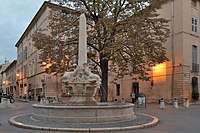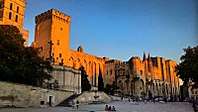Provence-Alpes-Côte d'Azur
Provence-Alpes-Côte d'Azur (French: [pʁɔvɑ̃s‿alp kot d‿azyʁ]; Occitan: Provença-Aups-Còsta d'Azur; Italian: Provenza-Alpi-Costa Azzurra; Région Sud) is one of the eighteen administrative regions of France, the far southeastern on the mainland. Its prefecture is Marseille. The region is roughly coterminous with the former French province of Provence, with the addition of the following adjacent areas: the former papal territory of Avignon, known as Comtat Venaissin; the former Sardinian-Piedmontese county of Nice, whose coastline is known in English as the French Riviera and in French as the Côte d'Azur; and the southeastern part of the former French province of Dauphiné, in the French Alps. Previously known by the acronym PACA, the region adopted the name Région Sud as a commercial name or nickname in December 2017.[2] 5,007,977 people live in the region according to the 2015 census.
Provence-Alpes-Côte d'Azur | |
|---|---|
 View of Menton on the French Riviera | |
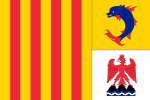 Flag  Coat of arms | |
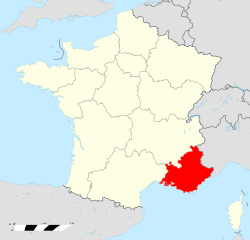 | |
| Coordinates: 44°00′N 6°00′E | |
| Country | |
| Prefecture | Marseille |
| Departments | |
| Government | |
| • President of the Regional Council | Renaud Muselier (LR) |
| Area | |
| • Total | 31,400 km2 (12,100 sq mi) |
| Area rank | 10th |
| Population (2015) | |
| • Total | 5,007,977 |
| • Density | 160/km2 (410/sq mi) |
| Demonym(s) | Provençals |
| Time zone | UTC+01:00 (CET) |
| • Summer (DST) | UTC+02:00 (CEST) |
| ISO 3166 code | FR-PAC |
| GDP (2012)[1] | Ranked 3rd |
| Total | €142.4 billion (US$183.1 bn) |
| Per capita | €28,861 (US$37,121) |
| NUTS Region | FR8 |
| Website | maregionsud.fr |
It encompasses six departments in Southeastern France: Alpes-de-Haute-Provence, Alpes-Maritimes, Bouches-du-Rhône, Hautes-Alpes, Var and Vaucluse. It is bounded to the east by the France-Italy border, to the south by the Mediterranean Sea and by the Principality of Monaco, to the north by Auvergne-Rhône-Alpes, and to the west by Occitanie, with the Rhône river marking its westernmost border. The region logotype displays the coat of arms created in the 1990s and which combines the coats of arms of the old provinces making up Provence-Alpes-Côte d'Azur. The region's economy is the third largest in France, just behind Île-de-France and Auvergne-Rhône-Alpes. Its GDP in 2012 was €142.4 billion (US$183.1 billion) while its per capita GDP was €28,861 ($US 37,121).
Demographics
Population
According to a 2015 census, the population in the region was 5,007,977; Marseille and its metropolitan area is the most populous in the region with a city population of 850,636, an urban population of 1,560,921 and a metropolitan population of 1,720,941. Marseille is the second largest city in France after Paris, and has the third largest metropolitan population, behind those of Paris and Lyon respectively.
Nice is host to the second-largest population concentration in the region, with a city population of 344,875 and an urban population of 1,005,230, making it the fifth-most populous city in France.
Languages
The absolute majority of the population speaks French and there are many minority languages. According to the 1999 Census, 4.39% (or 197.820 people) spoke English and 2.63% (or 118.512 people) spoke Italian with their relatives, friends or peers. Other minority languages were Spanish (2.38%, 107.247 people), Arabic (2.22%, 100.037 people), Provençal (2.20% or 99.136 people) and Corsican (0.58% or 26.135 people).[3]
Immigration
According to a 2009 study, nearly 40% of all newborns in Provence-Alpes-Côte d'Azur in 2007 had at least one parent of an immigrant background, mostly Italian, Spanish, Portuguese and Maghrebi. This is the second-highest rate after Île-de-France (Greater Paris), where the figure was around 56%.[4] Since the 1960s, the region has been a major immigration centre into France, mostly due to Mediterranean immigration from countries such as Portugal, Spain, Italy, Algeria, Tunisia and Morocco.
Departments
Provence-Alpes-Côte d'Azur is divided into 6 departments. These are Alpes-de-Haute-Provence, Hautes-Alpes, Alpes-Maritimes, Bouches-du-Rhône, Var and Vaucluse.
| Department | Area | Population | Prefecture | Sub-prefecture(s) | Population density | |
|---|---|---|---|---|---|---|
| 04 | Alpes-de-Haute-Provence | 6,944 km2 (2,681 sq mi) | 161,241 | Digne-les-Bains | Barcelonnette, Castellane and Forcalquier | 23/km2 (60/sq mi) |
| 05 | Hautes-Alpes | 5,549 km2 (2,142 sq mi) | 139,554 | Gap | Briançon | 24/km2 (62/sq mi) |
| 06 | Alpes-Maritimes | 4,299 km2 (1,660 sq mi) | 1,084,428 | Nice | Grasse | 252/km2 (650/sq mi) |
| 13 | Bouches-du-Rhône | 5,112 km2 (1,974 sq mi) | 1,984,784 | Marseille | Aix-en-Provence, Arles and Istres | 385/km2 (1,000/sq mi) |
| 83 | Var | 5,973 km2 (2,306 sq mi) | 1,021,669 | Toulon | Brignoles and Draguignan | 196/km2 (510/sq mi) |
| 84 | Vaucluse | 3,566 km2 (1,377 sq mi) | 546,314 | Avignon | Apt and Carpentras | 151/km2 (390/sq mi) |
Major cities
The largest cities in the region are Marseille (administrative capital city of the region), Nice, Toulon, and Aix-en-Provence, each with a population exceeding 100,000 inhabitants at the 1999 census. Along with Marseille, Nice is the second most populous city in the region with a city proper population of about 350,000 and an urban population exceeding 1 million.
Marseille, with an urban area of 2 million inhabitants, is the largest and capital city of Provence-Alpes-Côte d'Azur region. It is also the second most populated city in France, just behind Paris and the city with the third largest metropolitan population in France, behind Paris and Lyon respectively.
Along with Nice and Marseille the region is also made internationally popular with Cannes which, though not a large city (population of 73,603 in 2012), hosts the annual Cannes Film Festival which has highly popularized the region. Also, Arles has become renowned as the city in which Vincent van Gogh lived and painted 300 paintings.
Toulon is a large military harbour on the Mediterranean coast, with the French naval base placed there. It is the capital of the Var department in the region. Also, Aix-en-Provence has long been a university town, and to this day remains the most important educational centre in the region.
Below is a list of the most populated cities in the region along with their population (city proper) according to the most recent census.
- Aix-en-Provence – 142,743
- Antibes (includes Juan-les-Pins) – 76,994
- Arles – 52,729
- Aubagne – 46,423
- Avignon – 90,194
- Cannes – 73,603
- Draguignan – 38,258
- Fréjus – 52,389
- Grasse – 51,580
- Hyères – 56,275
- La Seyne-sur-Mer – 64,903
- Le Cannet – 40,940
- Mandelieu-la-Napoule – 22,714
- Marseille – 861,636
- Martigues – 76,471
- Mougins – 19,703
- Nice – 343,875
- Toulon – 167,729
- Villeneuve-Loubet – 14,427
Geography
This region has a total area of 31,400 km2 (12,100 sq mi). It has a wide variety of landscapes, from the Alps mountains to plains and coastal areas like Nice and Marseille, which form the majority of the land area. The region has a Mediterranean coastline on the south, on which the majority of its population lives. It borders Italy (Liguria and Piedmont) to the east, Monaco (Fontvieille, La Colle, La Rousse, Larvotto, Les Moneghetti, Les Révoires, Saint Michel) in the south-east, and the French regions of Auvergne-Rhone-Alpes to the north and Occitanie to the west. The Rhône, Var and Arc rivers run through the region. The borders were unaffected by the 2016 French regional reforms.
This region is famous for the Côte d'Azur (French Riviera), which spans the glamorous cities of Nice, Saint-Laurent-du-Var, Antibes, Juan-les-Pins, Cannes, Fréjus, Saint-Raphaël, Sainte-Maxime and Saint-Tropez.
Regional government and politics

The Regional Council of Provence-Alpes-Côte d'Azur is the legislative body of the region. The President of the Regional Council has been Renaud Muselier (LR) since 2017.
Political tendencies
In the recent years Les Républicains have gained strong support in the region and following the 2015 departmental elections, they control the region, which had been narrowly controlled by the Parti Socialiste with Michel Vauzelle previously.
The French Communist Party historically had several strongholds in the region from the 1920s onward, including Aubagne, Draguignan, La Ciotat, Beausoleil, Martigues, Gardanne, Arles and some suburbs of Marseille. Though not enough to win the regional elections, the party usually received about 10% of the vote. Beginning with 2002 this declined to 4% and by 2012, dropped below 2%.
The main competition seen in the politics of this region is between Les Républicains and the Parti Socialiste (PS), both deferring in its opinions. According to the most recent elections, the political tendencies are as follows-
| Élection / collectivités | Les Républicains (centre-right) | Parti Socialiste (centre-left) |
|---|---|---|
| Presidential Election (2012) (2nd tour) | 57.62% (Nicolas Sarkozy) (LR) | 42.38% (François Hollande) (PS) |
| Regional Councils | 51 (LR-NC-DVD-FN) | 72 (PS-PRG-Verts-PCF-DVG) |
| General Councils | 5 | 1 |
| Deputies | 27 | 15 |
| Senators | 13 | 9 |
Economy
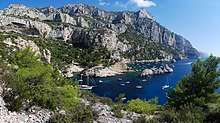
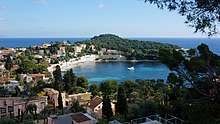

The regional income per capita is close to the French national average. Income inequality however is higher than in other regions: the region is ranked 4th by percent of population living above the poverty line. The region is ranked third by GDP. Between 2007 and 2011, the region registered an average annual growth rate of 1.6% of GDP (Eurostat), close to the national average annual growth rate of 1.5%. Representing 7.2% of the national GDP over the period, the region is an important economic powerhouse.
In 2013, the region was responsible for 7.4% of national employment, with an employment rate of 89.2%. The region's employment success has a main characteristic: a higher concentration of elderly people than in the rest of France (respectively 27.1% and 24.1% in 2013).
With more than 80% of regional employment in the service sector in 2010, the regional economy is mostly oriented towards service activities, above the national average of 76.3%. The sector grew between 2000 and 2010 (3.1% on annual average vs. 2.1% in France). The region concentrates more on commercial activities than financial ones than the rest of France does; principally because of tourism. 34% of the labour force is employed in retail and trade, against 32% at the national level. Moreover, the sector strongly contributes to growth of added value (81.5% vs. 77.3% at the national level). The industrial sector (existing mainly through the Marseille-Fos Port), including construction, consists of 17.1% of regional employment (vs. 20.6% in the rest of France), and contributes to 9.3% of gross added value, 3.2 points below the French level.
Employment in the agricultural sector is lower than the national level (2.4% against 3.1%). However, it grew at a rate of 4.1% annually on average between 2000 and 2008, while the rest of the country saw its agricultural employment decline by 2.4%. According to the Institut national de la statistique et des études économiques, the region is characterised by a strong presence of SMEs of less than 500 employees, which represent 91.2% of local businesses (higher than the national average of 90.9%). Retail activities and tourism explain these figures.
The region's economy is dependent on tourism like most coastal places but also a majority of its economy is dependent on coastal activities. PACA is the 3rd richest French region and ranks 19th on the European scale. Its prosperity is mainly thanks to its attractiveness in terms of tourism; it is indeed one of the world's favourite tourist destinations, welcoming about 34 million tourists every year. The service sector predominates and provides many good jobs. In 2009, the region was admittedly affected by the global economic crisis, albeit to a small extent. It is (after the Paris area) the 2nd French region with regards to business startups.
If tourism is the driving force of Provence-Alpes-Côte d'Azur, the region is also a leader when it comes to innovative sectors, such as high technology, biotechnology, and microelectronics. Education, for its part, is well developed with the region's various universities, international schools, preparatory classes for specialist university courses, and engineering and business schools. All these institutions of higher learning help contribute to the human capital needed by the region to meet current technological challenges.
The region has a total GDP (2012) of €142.4 billion (US$183.1 bn), the third highest in France. It has a per capita GDP of €28,861 (US$37,121), slightly higher than the French average. According to a recent survey, a person living in Provence-Alpes-Côte d'Azur has an average annual income of about €37,489 (US$45,755).
The region has been part of Alps–Mediterranean Euroregion since 10 July 2007.
Culture

The region is one of the most visited of France, and has therefore many well-known museums, mostly in Marseille: the Museum of European and Mediterranean Civilisations, the Musée Cantini, the Musée Grobet-Labadié, the Marseille History Museum, the Musée des beaux-arts de Marseille, the Musée de la Faïence de Marseille and the Muséum d'histoire naturelle de Marseille are some of the tourist spots of the city. However, other museums are internationally recognised, like the Musée Matisse, the Musée d'art moderne et d'art contemporain, the Musée Marc Chagall, the Musée international d'Art naïf Anatole Jakovsky, the Musée des Beaux-Arts de Nice, the Musée National du Sport and the Muséum d'histoire naturelle de Nice.
Transportation
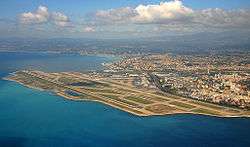
Airports
PACA has two of the busiest airports in France: Nice Côte d'Azur Airport (ranking 3rd after Charles de Gaulle Airport and Orly Airport) and Marseille Provence Airport (ranking 5th after Lyon–Saint-Exupéry Airport). Nice saw 13,850,000 people travelling through its airport in 2018, while 8,478,541 used Marseille to fly.
Minor airports include Montpellier–Méditerranée Airport (1,671,545 passengers in 2016) and Toulon–Hyères Airport (500,046).
Motorways
The region is at the centre of a complex and dense motorway network, in the heart of Mediterranean coast. Motorways are operated by ASF, ESCOTA, SMTC, MPM (Marseille Metropolis) and DIR Med (State). In PACA, motorways have the particularity to serve the city centres of big towns, unlike other big cities of France. This is due to their comparatively early construction in relation to the motorways of France's other regions.
- A7 - Autoroute du Soleil "Motorway of the Sun" links the region to Lyon and on to the North of France. This motorway starts in central Marseille at the Porte d'Aix. The road widens at Septèmes Valleys and meets the A51. After a junction with the A55 and connecting highways A517, A551 and A552, the motorway crosses Vitrolles in 2x2x2 lanes. It serves Marseille Provence Airport and the Aix-en-Provence TGV railway station high speed train station. After 10 kilometers, the A7 passes the Berre-l'Etang petrochimical complex at a junction with the D8 highway. After this it meets the A8 Provençal motorway at La Fare les Oliviers. After the toll station at Lançon-de-Provence, the road meets the A54 motorway at Salon de Provence. The motorway continues along the Rhône and Durance to Avignon and Orange until Lyon.
- A8 - La Provençale, crosses the region from west to east to Italy. This motorway starts from the A7 at La Fare les Oliviers. The first part of free-road starts and cross Aix-en-Provence to be linked with A51 and N296 motorways. After the Palette Valley, the motorway arrives to the La Barque tool and the junction with the A52 to Aubagne, Marseilles-East, and Toulon. Crossing the Var department with the A8/A57 junction at Le Luc en Provence, the A8 gets a mountain profile to cross the French Riviera : Cannes, Antibes, Nice. A connection is made with A500 motorway at La Turbie to serves the Principauty of Monaco. After Menton, the motorway cross the Italian border until Genoa.
- A50 - This motorway connects the east of Marseilles after the Prado-Carénage tooltunnel to Toulon. After crossing the Huveaune Valley and the South of Aubagne, the motorway goes near the coast to Toulon city center. The motorway crosses the city with a tunnel until the A57. It is a suburban motorway
- A51 - Autoroute du Val de Durance "Motorway of the Durance Valley". The motorway starts with the A7/A51/A517 junction in the north of Marseilles between Plan de Campagne and Septèmes Valleys. 20 kilometers after, the motorway stops at the A8/A516/A51/N296 junction in Southern Aix en Provence. At Aix North, the motorway restarts and goes to rural South Alps after Manosque. It ends near Tallard, at 20 km (12 mi) south from Gap.
- A52 - Grand Contournement de Marseille "Marseilles Bypass". The motorway starts at the A8/A52 junction in the Aix Est (La Barque). It is a mountain 2x2 motorway built at 20 km (12 mi) around Marseilles. After the A52/A520 junction and Pont de l'Etoile, it ends at Aubagne, connected with A501 and A50.
- A54 - Autoroute de la Crau "Crau's Motorway'. This motorway starts at the A7/A54 junction at Salon East and the crossing of Salon de Provence with 4 exits, the motorway arrives at the Crau Plain. It ends at the N569/A54 junction in Saint Martin de Crau. It re-begins at Arles West to Nîmes, Montpellier and Barcelona.
- A55 - Autoroute du Littoral "Coastal Motorway". This motorway starts at Port de Bouc. After the Martigues bridge, the motorway passes at the south of the Berre pond in the Estaque Mountains After the A7/A55/A551/A552 junction at Les Pennes-Mirabeau, it crosses the mountains and arrives at Marseille (Estaque district). After the junction of Grand Littoral, the way crosses the new Euroméditerranée Central Business District with a long bridge of 7 km (4.3 mi). Cars enters in the Joliette tunnel, continued by the Vieux-Port tunnel under the sea, and the Prado-Carénage tooltunnel. These three tunnels crosses the Marseilles city center. A55 is connected with A50.
- A57 - Autoroute des Maures "Arabic motorway". This motorways starts at A50/A57 junction after the Toulon tunnel. After the A57/1570 junction at La Valette du Var, the motorway continues along the plain of Maures to Cuers and Le Luc to be link with the A8.
- A500 - Tunnel de Monaco "Monaco Tunnel". This motorway starts at La Turbie (A8) at the West Monaco. The A8 goes over Monaco but A500 goes in Monaco with a 5 km (3.1 mi) tunnel to the principality.
- A501 - Aubagne bypass, connects A50 to A52.
- A502 - Garlaban motorway. This little motorway connects the A50 from Aubagne to Aubagne East to the Garlaban mountains.
- A515 - Junction from A51 to Gardanne.
- A516 - L'Aixoise. This motorway connects the A51 southern East Junction to Aix city center.
- A517 - Convergent de Septèmes-les-Vallons "Convergent of Septemes Valleys". Link between A7 and 51
- A520 - Autoroute de la Sainte Baume "Ste. Baume motorway". This motorway starts from A52 at Pont de l'Etoile and ends at Auriol East to be connected with N560 to the Sambuc pass and Saint Maximin la Sainte Baume
- A570 - Autoroute de la Côte "Motorway of the Coast". Link between A57 and Hyères. The national road N97 continues after to Saint Tropez
- N113 - Highway in Vitrolles along the A7. Highway of the Crau Plain between Saint Martin de Cray (A54) to Arles West (A54)
- N296 - Aix en Provence bypass.
- N569 - Port of Fos-Marseille.
- D6 - highway of Arc Valley from A515 to Rousset-Peynier Technologies center.
- D8 - Petrochimical area of Berre.
- D9 - Link between Marseille Provence Airport, Aix TGV high speed train station, the Arbois desert, the Europolis and Aix en Provence.
Trains
High speed services

The region is served by 13 high-speed trains stations and one more in the Principality of Monaco. Two stations are situated on the HSL LGV Méditerranée opened in 2001: Avignon TGV and Aix-en-Provence TGV. The others stations served by high-speed services are Avignon-Centre, Arles, Miramas, Marseille-Saint-Charles, Toulon, Les Arcs-Draguignan, Saint-Raphaël-Valescure, Cannes, Antibes, Nice-Ville and Menton.
Services operated
- Paris GDL to Avignon-Centre / Miramas
- Paris GDL to Marseille, Toulon, Nice, Monaco and Ventimiglia (Italy)
- Nantes / Rennes to Marseille
- Strasbourg to Marseille
- Lille to Marseille
- Nancy / Metz / Dijon to Marseille / Nice
- Le Havre to Marseille
Services operated by SNCF Ouigo:
- Marne-la-Vallée – Chessy to Marseille
- Lyon-Perrache to Marseille
Services operated by SNCB/NMBS TGV:
- Bruxelles Midi/Brussel Zuid (Belgium) to Marseille and Nice
Services operated by CFF Lyria:
- Genève (Switzerland) to Marseille and Nice
Services operated by DB Alleo:
- Frankfurt am Main (Germany) to Marseille
Services operated by Renfe AVE:
- Madrid-Atocha (Spain) to Barcelona (Spain) to Marseille
Services operated by Eurostar:
- London Saint Pancras Int. (UK) to Ashford (UK) and Marseille
Services operated by Thalys (seasonal):
- Amsterdam (Netherlands) to Brussel (Belgium) and Marseille
National services
Despite the importance of the region in the national economy and demography, the national services on conventional network are not very high due to the fact of the saturations of the tracks with high speed and regional trains.
Services operated by SNCF Intercités:
- Bordeaux-Saint-Jean to Toulouse, Montpellier, Marseille-Saint-Charles and Nice
- Paris-Austerlitz to Marseille-Blancarde and Nice (night train)
- Paris-Austerlitz to Gap and Briançon (night train)
Services operated by Thello Eurocity:
- Marseille-Saint-Charles to Nice, Monaco, Ventimiglia, Genoa and Milano Centrale (Italy)
Regional services

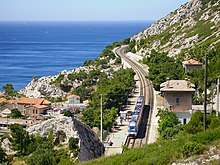
All regional trains services are operated by SNCF TER Provence-Alpes Côte d'Azur, except between Nice and Digne-les-Bains, operated by CP, the own-region company. The Regional Council of Provence-Alpes Côte d'Azur is the transport authority and defines the services in all region. An attractive fare permits to transport more than 100,000 passengers every day in 750 trains. Trains are leaving every 15, 20, 30, 60 or 120 minutes on each line.
With only one big line, the tracks are saturated causing delays or cancellations. The region has to rent other trains from other regions to respond at the offer. In 2016, during the second Council of the Year at the Region Hall in Marseille, in front of politicians and the new president of the Regional Council of Provence-Alpes-Côte d'Azur Christian Estrosi, the SNCF CEO, Guillaume Pepy, has announced the impossibility of the company to respond to the demand. The Marseille-Saint-Charles Station, the Marseille's main railway station can't support more than 23 trains an hour and the tracks are too old and not enough to accept an average of the capacity. The project of new high-speed line called LGV PACA in 2030 could permit to increase trains on tracks with a new crossing of Marseille with a tunnel. Two new stations will be created in the territory of the city and a new line between Cannes and Nice Côte d'Azur Airport.
Services operated by CP:
- Nice CP to Colomars and Plan du Var
- Nice CP to Digne-les-Bains
Services operated by SNCF are declined with two appellations unlike other regions : TER, normally suburban trains and Intervilles, long-distance regional trains. Services operated by SNCF Intervilles:
- Marseille-Saint-Charles to Toulon, Nice and Monaco
- Marseille-Saint-Charles to Gap and Briançon
- Marseille-Saint-Charles to Avignon and Lyon-Part-Dieu
- Marseille-Saint-Charles to Montpellier, Narbonne and Perpignan
- Briançon to Gap, Valence TGV, Valence-Ville and Romans-sur-Isère
- Avignon-Centre to Montpellier, Narbonne and Perpignan
Services operated by SNCF TER:
- Marseille-Saint-Charles to Marseille-Euroméditerranée, Port-de-Bouc and Miramas
- Marseille-Saint-Charles to Vitrolles MP Airport, Miramas and Avignon-Centre
- Marseille-Saint-Charles to Vitrolles MP Airport, Miramas, Nîmes and Montpellier-Saint-Roch
- Marseille-Saint-Charles to Marseille-Euroméditerranée, Vitrolles MP Airport, Salon-de-Provence, Avignon-Centre and Avignon TGV
- Marseille-Saint-Charles to Saint-Antoine, Aix-en-Provence and Pertuis
- Marseille-Saint-Charles to Saint-Antoine, Aix-en-Provence and Sisteron
- Marseille-Saint-Charles to Marseille-Blancarde and Aubagne
- Marseille-Saint-Charles to Marseille-Blancarde, Aubagne, Toulon and Hyères
- Marseille-Saint-Charles to Marseille-Blancarde, Aubagne, Toulon and Les Arcs-Draguignan
- Avignon-Centre, Valence and Lyon-Perrache
- Avignon-Centre to Nîmes, Montpellier, Narbonne and Perpignan
- Avignon TGV to Avignon-Centre and Carpentras
- Les Arcs-Draguignan to Cannes, Nice, Monaco and Menton
- Grasse to Cannes, Nice, Monaco, Menton and Ventimiglia (Italy)
- Nice-Ville to Breil-sur-Roya and Cuneo (Italy)
- Briançon to Gap and Grenoble
Environment
The mining company Alteo processes bauxite to produce aluminium, resulting in various waste materials such as "boues rouges" (red mud) and arsenic. The dumping of this waste in the marine reserve of the Calanques National Park for 6 years was authorised by the French government in 2015. Company representatives have dismissed environmental concerns as exaggerated and uninformed.[5][6][7][8] The region also includes another National Park, the Port-Cros National Park near Toulon.
Due to motor vehicle traffic, the urban areas are often saturated on a daily basis, but cities are investing in public transport networks such as Marseille's subway (2 lines) and tramway (3 lines), Aubagne tramway (1 line) and Nice tramway (1 line). Other networks existed at the beginning of the 20th century in smaller cities such as Aix-en-Provence, Avignon, La Ciotat and Toulon but are now gone.
Education
Major universities of the region include the Aix-Marseille University, the University of Toulon, the University of Avignon and the University of Nice Sophia Antipolis. Other towns have higher education classes but no universities.
References
- INSEE. "Produits intérieurs bruts régionaux et valeurs ajoutées régionales de 1990 à 2012". Retrieved 2014-03-04.
- https://www.lemonde.fr/societe/article/2017/12/16/la-provence-alpes-cote-d-azur-ne-sera-plus-surnommee-paca-mais-region-sud_5230750_3224.html
- "Langues et cité - L'occitan" (PDF). Ministère de la Culture. 2007.
- Bardakdjian-Michau J, Bahuau M, Hurtrel D, et al. (January 2009). "Neonatal screening for sickle cell disease in France". J. Clin. Pathol. 62 (1): 31–3. doi:10.1136/jcp.2008.058867. PMID 19103855.
- (in French) Le Monde
- (in French) Le Figaro
- (in French) boues rouges
- (in French) Le prefet autorise pour 6 ans le rejet des boues rouges
External links
| Wikimedia Commons has media related to Provence-Alpes-Côte d'Azur. |
| Wikivoyage has a travel guide for Provence-Alpes-Côte d'Azur. |
- Provence-Alpes-Côte d'Azur : soft singsong accents- Official French website (in English)
- Provence-Alpes-Cote d'Azur at Curlie
- Conseil régional Provence-Alpes-Côte d'Azur Official website
- FranceSouth.com Provence-Alpes-Côte d'Azur Guide

.jpg)
